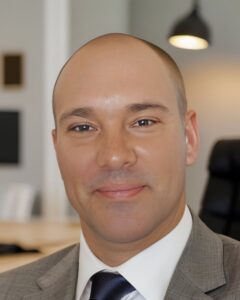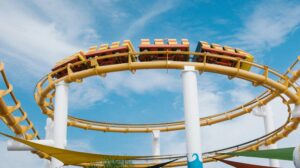
Aquinas Engineering is proud to have a dedicated team with years of experience who exhibit excellence in their work. The purpose of this series is to give light to the amazing human beings behind our projects. Below is a transcription of a conversation between Administrative Coordinator Bernardo Castellanos and Senior Project Manager Ryan Martinson.
Bernardo: What is your name and how long have you been with Aquinas Engineering?
Ryan: My name is Ryan Martinson and I have been with Aquinas Engineering for a year and a half.
Bernardo: What do you like to do in your free time?
Ryan: Well, we live on an acre and a half with two dogs and two horses. So, the weekend to-do list around our home always keeps me busy. I love to golf-even if its 110+ (less busy). There are a lot of great hiking opportunities here in Arizona. The Superstition mountains are not too far away to get some beautiful hikes in. I do dog agility with my two Pomeranians. [I like to] help out my wife when she is doing her horse training and riding the horses. Just enjoy the time with family since time is so short. And when the weekend comes and it’s a beautiful evening, I might enjoy a fine cigar.
Bernardo: Very nice. Lots of outdoor activities. What inspired you to pursue a career in civil engineering?
Ryan: Since a young kid I always enjoyed LEGOs, model cars and trains, blocks and puzzles, and skyscraper structures. But really the inspiration to pursue engineering came from my passion of roller coasters. I was obsessed – fascinated with them. I grew up in South Dakota, so summertime was usually our family’s time for vacation and travel. And every springtime when we would have our family meeting to discuss summer plans, we would offer suggestions on what we want to do for that vacation. I would usually vote for an amusement park. I just loved towering structures, the steel, the wood, watching physics in motion, watching the train glide along the track. I was just infatuated. I loved the speed and thrills riding too. When I was about 12-13 years old, I reached out to a company in California I had found that designed coasters and amusement park rides. I shared my passion for coasters explaining I wanted to design them. I asked what skills and education do you need to design coasters? And they actually responded saying ‘Well, we have electrical engineers, mechanical, and structural engineers’. That was the moment I knew I wanted to pursue civil/structural engineering.

Bernardo: Wow. Very cool inspiration. What is your favorite part of working with Aquinas Engineering?
Ryan: Honestly, the people that makes it. I have known Ismael for going on 9 years. He and I have a great friendship and comradery and the people that work here are just so wonderful and pleasant; its like a family. And it just makes the days working with them so enjoyable. So, I would have to say the people are just wonderful.
Bernardo: That’s great to hear. What software tools do you find most useful in your work?
Ryan: Aquinas has a range of software that are fairly common with structural engineering firm: MathCAD, Excel, RISA 3D. We have a glass finite analysis software that allows us to review and design structural glass applications. But I think just the other tool that people often forget is the other engineers and people there that are always a good sounding board. I always like bothering Ismael or Mario for support or advice.
Bernardo: That’s good. Very underrated and not spoken about a lot but that is a great tool. What role does sustainability play in your projects?
Ryan: Sustainability. Well, that’s a pretty large, broad topic. I think it covers a lot of professions and every person really. Engineering in the construction industry especially – it’s a very huge impact on the environment. We typically have a small scope on a project in terms of the relative view of the whole thing. Ours is small. But any impact, minimal or otherwise, can be beneficial. So, I think it’s important, both professionally, and personally. Personally we try to implement things in our home: recycling, reusing, things like that. And professionally, talking with our clients asking ‘What products do you guys like to use?’. Maybe there’s something that they already have in stock, not kind of creating something new. Maybe it’s more regional. Instead of specifying a product that can be anchors or steel or whatever product, is it something that they can obtain locally, near them, or near the project even better instead of having to go across country to ship which costs gas and carbon emissions,etc. Having the conversation with the client on what helps them be successful on the project. What helps them become more efficient? Maybe its small enough to say, ‘hey instead of having 6 different anchor configurations, lets narrow that down so you don’t have to order so much’. Is this product available or is it on back order or is it cost effective? Or is it more expensive for another reason? Again, those are all minimal and they are all construction projects, but any minimal impact can help make a difference over the long run.
Bernardo: That’s great. The last few questions are based more off your experience and projects that you have done in the past. First one is: Can you describe a challenging project you’ve worked on and how you overcame the obstacles?
Ryan: Actually, I’ve been doing this for 18 years so I have a wonderful pot to draw from. We were tasked with designing the exterior aluminum frame glazed curtain wall system for a project in Los Angeles. And it was a beautiful architectural building. Lots of windows and open space. What made this project a little more unique was the aluminum framing members, the horizontal and vertical mullions, were not what you would see common in the industry for those members. They were much narrower and sleeker, which was probably why the architect liked them. [They] created more of a glass look and minimized the structural framing. So, it created some challenges on the design of the system as well as the connections to the structure. We came to the seismic design portion and one problem arose, tried to resolve that, and another one arose. Finally, after some effort, I reached out to a fellow engineer. I said ‘here are the challenges on this. I’ve come up with ‘this’ option but then I have ‘this’ concern/issue. Or I have these concerns: A, B, C with these solutions.’ Talking the problem with another engineer who had more experience than I did, helped. He also shared that he had similar projects that he worked on that came across the same challenges which I didn’t know at the time. So, we were able to some ideas off each other and came up with a solution to get it to work out structurally.
Bernardo: And that really goes back to what you were saying about the most important resource: is other engineers that you can bounce off. What has been the most rewarding project you have worked on in your career?
Ryan: Going back to when I was about four years into my career, I was working at a structural engineering firm in St. Paul, Minesota. They had secured a wonderful, huge, and impressive, both in scope and architecturally, new development project for a company’s campus headquarters in Wisconsin. And this project was ginormous: a 1100 acre campus with office buildings (22 now), auditoriums, training facilities, food service buildings, underground parking structure with tunnels,. Our scope for this one particular phase involved four new office buildings accounting for about a million square feet of office space. I had the fortunate blessing to be a part of the team to design these 3-story steel-frame structures. That was my introduction to structural engineering of a steel building at that time. I was trusted with more responsibility each passing phase. I was tasked the first building’s design of the gravity system (beams, girders, and the columns) for the gravity loads. I used the RISA-3D software to do that. Even looked at the floor vibrations. What was great about the project was I was able to not just do it once, but I was able to do it 4 times with the subsequent building phases. And each time I was able to get more experience and more control and oversight, worked more with the architects, and worked with our CAD department to develop the structural drawings. Also was entrusted to provide the quality control for the steel fabrication drawings. Overall, just a wonderful, enlightening engineering experience. Being a part of a project that you get to do not just once, but over and over. You get to do a little bit more each phase. That was cool.
Bernardo: Fantastic. That sounds like a great experience. Last question: What has been your favorite project?
Ryan: Again, I have been so blessed over my career to be a part of a lot of great projects, teams and engineers. My family and I were living in Honolulu at the time, and I was working for a structural engineering firm. To think on it there are actually several projects I can quote from Aquinas as well and put on this list, but this has to be one because it was Hawaii’s first elevated light rail project. And it came with a huge price tag. It came with support; it came with opposition. And it changed the landscape of the island. But it also would provide transportation relief to the severely congested freeway and obviously it would help me out too. I lived on the west side of O’ahu and had a long commute into work downtown. I was part of the project team to design 4 of the 19 light rail stations. It was a 20-mile elevated light rail line and just to be a part of that was quiet amazing. Yeah, it was a high-profile project and all, but it was another introduction to a part of structural engineering that I was able to gain invaluable experience. I worked with some phenomenal engineers and learned a lot. We designed the steel HSS pedestrian bridges that spanned from the west-bound side over the road to the east-bound side. It had two levels: a concourse and platform level. And then we designed the station’s platform girders, which was something that I had not done up until that time. These girders were designed as pre-cast, post-tensioned segmental concrete girders. Designing those [members] also utilized computer software beyond the day-to-day analysis what I normally used the software. It was overall just a wonderful structural engineering experience. Working with the architects and the other project team was phenomenal to be a part of that.

Bernardo: That’s awesome. You have so much experience in your career, and we’re blessed to have you here at Aquinas Engineering so that you can continue to use that experience in all the projects that we do. Thank you so much again for your time and for sharing all that with us.
Ryan: Of course. Thank you for allowing me to share that. Again, there’s so many projects to choose from. Here at Aquinas, there has been a lot of great ones. We have some great clients and projects across the country that we enjoy being a part of. It’s hard to choose but there are some memorable ones that we’re making.
Let us build a personal relationship with you. Contact Aquinas Engineering or visit our website to collaborate on your next project.







